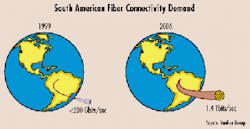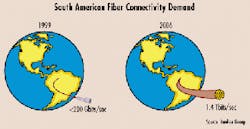Global Crossing, Telefonica, 360networks in tight race to deliver undersea cable capacity to Latin America
Global Crossing, Telefonica, and 360networks (formerly Globenet) are vying to be the first-to-market with pan-regional, wholesale broadband capacity for South America's first broadband undersea cable system. Meanwhile, WorldCom and Telecom Italia are waiting in the wings, contemplating the feasibility of leading another consortium-backed cable to the region. According to a new study from Boston-based research and strategic consulting firm Yankee Group, this "hotly contested" race is definitely worth running.
Yankee Group analysts predict that the total carrier demand for undersea cable capacity in Latin America will surpass 110 Gbits/sec by the end of 2001. This demand will experience a compound annual growth rate of approximately 68% per year through the forecast period, to reach a total of at least 1.4 Tbits/sec by 2006 (see Figure). The wholesale market could reach as much as $3 billion by the end of 2001 and account for approximately $21 billion by 2006. Global Crossing, Telefonica, and 360networks are all in the running, but their success will depend not on price, but on quality of service, in-country network "capillarity" (back-haul), and corporate relationships.There is certainly no shortage of demand for such a network. Approximately 31 million Hispanics currently reside in the United States, and they spend, on average, twice as much on long-distance calls per month than the average American. Virtually all of these calls go to Latin America. According to the report, intern a tion al voice traffic in Latin America has been growing faster than in other developed countries, and an undersea cable system would capitalize on this steady traffic flow.
In addition, most Internet content and e-commerce companies targeting the Latin Ameri can market are located in the United States. As a result, bandwidth demand among Latin American markets and the United States will be propelled initially by connections that originate in Latin America. The bulk of this traffic will flow from the United States to the user in South America.
However, as Internet usage expands among Latin American users, content and e-commerce companies hosted within the region should emerge, which will result in an increased number of connections initiated in the United States. The broadband traffic flow from Latin America to the United States should be substantial, driven by the growing Hispanic population within the United States as well as businesses with interest in the region.
Though Yankee Group analysts expect to see additional companies enter the fray, they believe only three full-ring systems will be able to maintain viable business plans, and they assert that Global Crossing, Telefonica, and possibly 360networks will have a firm hold on the pan-regional market.
For more information or a copy of the report, "South America at Light Speed: Undersea Cables and the Birth of a Wholesale Industry," visit the company's Website at www.yankeegroup.com, e-mail [email protected], or call (617) 956-5000.

